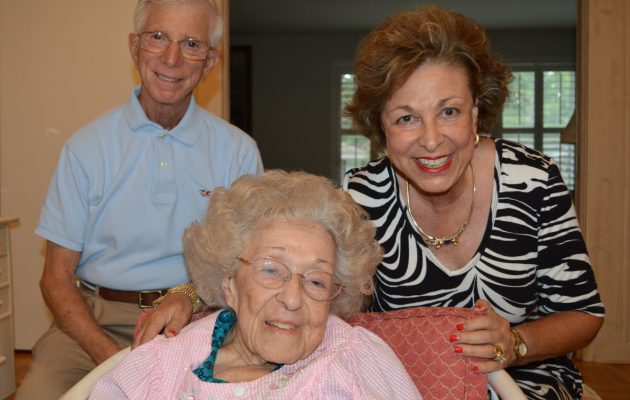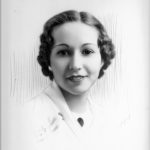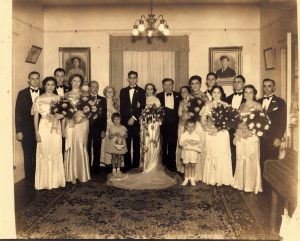The Way We Were: Helen Peltz Diamond


Engagement photo, 1934
A “firecracker baby” who was born on the Fourth of July more than 100 years ago, Helen Peltz Diamond has seen more Independence Day celebrations than she may care to mention. This year, however, may have been a celebration for the ages.
Knowing Diamond had surpassed her centennial year, more than 100 of her neighbors and friends stopped at the end of her driveway to sing a rousing rendition of “Happy Birthday,” before they finished their march down Waterman Road during the Colonial Manor neighborhood annual Fourth of July parade.
It was the second year Diamond, who had turned 102, was serenaded by her San Marco neighbors, and it was a fitting commemoration to the woman who is the oldest member of the Jacksonville Jewish Center and Colonial Manor resident with the longest tenure – 64 years – living on her street.
Diamond claims her “longevity gene” was received from her mother’s side of the family. Her mom, Fannie Schemer Peltz, lived to be 84 and had two sisters who lived to their early 90s in a time when most women died by age 57 and a man’s average life span was 52. Meanwhile, Diamond’s younger sister, Sylvia “Tootsie” Peltz Hecht, died at age 98; her older brother, Mitchell Peltz, lived to be 92.
Taking this into consideration, Diamond attributes her longevity to her “history.”
“She never did anything to override her good genes,” said Diamond’s daughter Rita Stearman. “She never drank. She was never a smoker or sat out in the sun. She never let her weight get out of control.”
It is hard for Diamond to select one time in her life as the good old days. “I never experienced hardship at any time,” she said, noting her parents owned a house, car and grocery store, which was a big deal. “When I was growing up I didn’t feel deprived of anything,” she said.

Wedding, August 19, 1934, Jacksonville, Florida. Portraits of Helen’s parents hang on the back wall of her Springfield home.
Diamond’s immediate family came to America when her mother immigrated at age 12, arriving in Baltimore, Maryland, from Lithuania to escape the pogroms in Eastern Europe. An uncle had forwarded money for her ticket so she traveled alone, and upon arrival at his home, she immediately went to work in a pajama factory, because at that time there were no child labor laws. Speaking only Yiddish, she worked to pay her uncle back and send money so her brother could make the trip from Europe the next year. Eventually the entire family came over, traveling one at a time, said Stearman.
“It was like ‘Fiddler on the Roof,’” explained Stearman, noting many Jewish parents would cut off their young sons’ trigger fingers to avoid having them conscripted into the Russian Army.
“My grandmother knew little or no future in Lithuania. She came over here by herself at age 12, but this was not unusual. Grandpa said if you were a Jew in America you were descended from people who had nothing, because the ones that had nothing came and the ones that had something stayed. The German Jews, they all stayed and they were all killed in the Holocaust,” said Stearman.
“My mother said they came (to America) to get a better life for their children,” said Diamond.
Eventually, Schemer met her husband, Harry Peltz, in Baltimore. Baby Helen was born on July 4, 1914. When she was six weeks old, her family moved to Jacksonville to live near their relatives and to escape the cold weather, Stearman said.
The Peltz family made its home at 805 West Duval Street in LaVilla, just down the street from the synagogue when it was on Duval Street. During those days LaVilla was the heart of the Jewish community, Diamond said.
Her father owned Star Grocery at the corner of North Davis and West Duval Streets and sold food and produce in the days before such things were prepackaged, she said. Flour was stuffed into burlap sacks and weighed by the grocer, Diamond recalled, noting her father, who was not overly religious, did not operate a kosher market. Later, her father moved his store to 3rd and Walnut Street, and it was there he sold meat, she said. “There was only one establishment that sold kosher things and there wasn’t a wide variety,” Diamond said.
Eventually her folks moved to 334 East 4th Street, where she lived when she was married, said Diamond whose sharp memory allows her to easily reel off her old addresses.
Growing up she attended LaVilla Elementary and Kirby-Smith Junior High before graduating in 1932 from Andrew Jackson High School, one of three all-white high schools in the city. It was during her high school days she met her future husband, Frank Diamond, whose father, Joe, had a pawn shop and manufactured Diamond’s Rheumatism Powder in the days before the Food and Drug Administration.
Frank and Helen were married August 19, 1934, in the synagogue at 3rd and Silver Streets, when she was 20 and he was 22.
“I met him at the YMHA,” she said explaining “things were segregated back then,” and Jews used the Young Man’s Hebrew Association, not the YMCA, which was the Young Men’s Christian Association.
She and her friend, Rosslyn Magezis, were dropped off at the YMHA by her parents and were to call for a ride home when they were ready to leave, Diamond recalled. During the game Magezis met a boy who offered her a ride home. “She told him, ‘I can’t go. I came with my friend Helen.’ He said he came with his friend (Frank), and was sure his friend would be glad to take her home, too,” Diamond said.
After the wedding, the couple moved around the corner from Helen’s parents to the Juliana Apartments on 3rd Street. Frank got a job at Cohen Brothers Department Store, where he was paid $22.50 a week, said Diamond.
Realizing his job had no room for advancement, Frank decided to move to Atlanta and enroll in Georgia Tech, where he could work during the day and go to school at night. There he sold his father’s rheumatism powder and later took a more lucrative job selling “debit” insurance door to door. When the school upped tuition by $50, Frank dropped out of college to sell insurance full time, Stearman said.
Diamond’s first child, Ivan, was born in 1940, and her daughter, Rita, came along three years later. A few years later, when World War II was in full swing, Frank was finally drafted into the army. Helen headed back to Jacksonville to live with her parents and be near her husband who was stationed at Naval Air Station Jacksonville. Frank, who worked in the office on base, saw many of his shipmates shipped to the Pacific in the middle of the night. “My father was saved when Harry Truman decided to drop the bomb,” said Stearman. “Dad never made it out of the continental United States and then the Japanese surrendered,” she said.
Once out of the military, the Diamonds stayed in Jacksonville and Frank settled into a very successful 41-year career selling Gulf Life Insurance.
The Diamonds were conscious they were the only Jewish family in the neighborhood when they spent between $3,500 and $4,500 to buy their home at 5505 Liberty Street, just down from North Shore Elementary. “I think Ivan and Rita were the only Jewish children in the whole school,” said Diamond.
In 1952 when the couple desired a larger house in a nicer neighborhood, they spent $4,000 on a lot in a brand-new San Marco subdivision on Waterman Road and built the house where Diamond still lives. “There were empty lots all around. I think we were the ninth house built on Waterman Road,” said Stearman, who was nine years old at the time.
“This area was lovely. It was considered an exclusive neighborhood,” Diamond said, adding most residents owned cars and “the hired help” who worked in the neighborhood used the 31 Colonial Manor bus. “Most everyone had someone who worked either all day or half a day,” Diamond said.
At that time, Waterman Road had a dozen or more Jewish families, including Diamond’s sister Tootsie, who lived directly across the street, said Stearman. “My non-Jewish friends told me they used to call it Little Jerusalem. The talk among non-Jews was that this was predominantly a Jewish neighborhood. But one day, being Jews because Jews like to know this kind of thing, we went and counted and there were still more non-Jews than Jews living here,” she said.
After World War II many Jewish families migrated from Springfield to South Jacksonville even though the conservative synagogue was still located on 3rd and Silver Street. As more Jewish families moved down the “San Jose Boulevard corridor” to points south, the synagogue, known today as the Jacksonville Jewish Center, moved to Crown Point Road in Beauclerc in 1976, said Stearman.
Frank Diamond was a founding member of Beauclerc Country Club, where the Jewish Community Alliance is now located. The club was established because San Jose Country Club would not admit Jews into its membership, Stearman said. “This was the height of discrimination. I tell all my friends that the Christian community discovered Jews had green money and that they could pay dues,” Stearman said. “Every community who gave Jews a chance has been enriched by their intellect and their generosity and their philanthropy,” she said, adding it was the Wolfson family who gave money for Wolfson Children’s Hospital and the land for Wolfson High School.
Although Diamond said she never felt any discrimination living in Jacksonville as a Jew, her daughter explained that during much of her mother’s early life, the Jewish Community, which is only one percent of the population, kept to itself.
“She would not go out with someone who was not Jewish, and non-Jews didn’t date Jews,” said Stearman. “The most important thing in the Jewish community was the synagogue. If they got there and there wasn’t a synagogue they built one in the midst of where they lived.”
Although she doesn’t often go to synagogue now, running a traditional Jewish household with its many holidays was the center of her married life, said Diamond, who grew up in a kosher home. “I used to keep kosher, but I don’t anymore,” she said.
“Mom and her sister would cook and bake together for the holidays. We used to have big family dinners with 25 or more,” recalled Stearman. “Traditions are not passed down, they are taken up. They would make all the traditional food, then when she couldn’t do it anymore, I took it up and now do it at my home,” she said.
By Marcia Hodgson
Resident Community News






